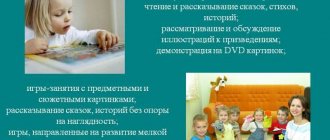Speech is the highest mental function. It depends entirely on the level of development of the human central nervous system. It is not only a means of communication, but also the basis of thinking. A child with undeveloped speech cannot fully analyze and classify his impressions, make generalizations and conclusions about the world around him. It is not without reason that most parents and specialists: doctors, speech pathologists, speech therapists, teachers, and psychologists attach such importance to the development of speech in preschool children.
The ability to clearly express one’s thoughts determines whether a child will be able to communicate freely and naturally with others. Children with developed speech actively play and communicate with peers, contact adults, and share their impressions. A child who realizes that his speech is different from the speech of his peers may begin to feel embarrassed communicating with children and adults, avoid playing together, and be afraid that they will laugh at him.
To find out whether a one-year-old baby is developing correctly, you need to know what is normal and what is pathological between the ages of birth and one year, and how you can stimulate his speech development on your own.
Stages of speech development
The development of a child’s speech from birth to one year is conventionally divided into four stages of unequal duration. The pace of development of children may not coincide in time, but this approximate periodization allows us to separate normality from pathology:
- Screaming stage. Lasts from birth to 6–8 weeks. Both the cry and the sounds made by the baby are reflex sounds. Most often these are vowel sounds with a nasal connotation. A short inhalation and an extended exhalation are accompanied by a loud cry.
- The buzzing stage. Lasts from two to five months. A child’s cry takes on an intonation coloring; it changes depending on the baby’s condition. Humming sounds and their combinations with vowels can occur both spontaneously and when communicating with an adult (agu, gee, khy, aga, ga, ege, aa). And this already becomes the beginning of the most important period - communication, communication with others. It is accompanied by the appearance of a “social” smile for everyone who communicates with the child, and a little later - the first laugh, similar to a squeal. Gushing occurs as you exhale, this is how speech breathing is trained.
- Babbling stage. The longest stage takes about 6–7 months and lasts almost until the end of the first year of life, or more precisely, until the age of 11 months. It is characterized by babbling, consisting initially of individual syllables (pa, ba, la), later turning into syllable chains (pa-pa-pa, ba-ba-ba, la-la-la), and then into the next stage - the first words that often consist of two identical syllables (pa-pa - dad, ba-ba - grandmother, la-la - doll). The oral cavity becomes more perfect, the tongue has the ability to perform a variety of movements. This makes it possible for the child to pronounce various sound complexes that sound similar to syllables with a vowel at the end: ma-ma-ma, pa-pa-pa, yes-da-da, nya-nya-nya.
- First words stage. Lasts until the end of the first year of life. These words (about 20–25) often consist of two identical syllables. This is the stage when the child begins to correlate babbling complexes with specific words. He doesn’t just pronounce a chain of syllables ma-ma-ma, but correlates the word ma-ma with a real object, reacts to the appearance of dad with the word - pa-pa. The child at this stage actively maintains contact with the adult through object-based means, manipulation with toys and objects. At the same stage, the understanding of addressed speech intensively develops, the baby actively begins to accumulate a passive vocabulary. He can't say donkey yet, but if you ask for a donkey toy, he will give it.
When to contact a specialist
All children develop differently, some begin to speak earlier than their peers, others later. Norms do not always serve as a guideline that a child is developing incorrectly. But, we advise you to consult a doctor in the following cases:
- At 2 months the baby does not cry before feeding.
- At 5 months the baby does not smile or coo.
- At 6 months the baby does not listen to speech or music.
- At 7 months he does not recognize the voice of his family and does not show any reaction to intonation.
- At 9 months he does not babble, does not repeat syllables or combinations of sounds after adults, does not imitate the intonation of his parents.
- At 11 months he does not wave when denied, does not say goodbye with a gesture.
- At one year old, he cannot pronounce simple words, does not fulfill basic requests, “bring”, “give”, “show”.
From the very birth of a child, you need to deal with his development. The more often you talk to your child, the faster he will speak. If a mother is a silent person and instead of spending active time with her child she sits on the phone, then it is not surprising that the child will speak later than his peers.
Age norms by month
Average indicators of speech development are important for determining normality or pathology. They can shift depending on the individual characteristics of the baby and the conditions of his growth. It is known, for example, that every serious illness suffered by a young child “throws him back” a little in terms of the development of skills and abilities.
- The first month and a half of life. Sounds appear with which the child reacts to the speech of the mother and other close people addressed to him. These are mainly vowel sounds and their combinations (o, a, u, ya, ay, ua). The child is able to focus his gaze on the faces of his relatives, on the toys shown to him, and listen to the sounds of human speech. During this period, children with prerequisites for a future speech disorder can be identified by assessing the nature of their cry - shrill or very quiet; sobs or screams are possible while inhaling, and not while exhaling, as is expected during normal development.
- At 2–3 months, the “revival complex”, consisting of characteristic movements of the arms and legs at the sight of the mother, is accompanied by guttural sounds and their combinations with vowels (a-a-a, a-a-gi, a-a-gu, a- ha). Such hooting occurs not only when in contact with familiar close people. It can occur spontaneously when the baby is full and happy, or when looking at a toy. Another achievement of this stage is auditory and visual concentration on the source of sound or movement.
- At 3–5 months, the child seeks contact with adults with his gaze, smile, and utters drawn-out sounds - humming. They most often consist of sound combinations such as gee, khy, agu, aga, ga, ege, aa. Sometimes these combinations are so bizarre that they are difficult to reproduce. The pathology at this stage is considered to be monotonous humming sounds accompanied by chaotic movements of the arms and legs, and a lack of intonation expressiveness.
- At the 6th month of life, babbling appears in the child’s speech, consisting of such combinations of sounds as “ga, ka, pa, ma.” Constantly repeating themselves, they already become quite similar to models of words, as if pronounced syllable by syllable: “ma-ma-ma-ma, ba-ba-ba.” Such improvisations appear only in a good mood, and for now they cannot be a means of communication. During this period, congenital deafness can be diagnosed, because a deaf child has no babbling, and the sounds of humming gradually fade away.
- At the 7th month of life, a connection appears between an object and the word denoting it. If parents specifically pay attention to this skill, show objects and toys, naming them several times, then the child will quickly learn to look for them at the request of an adult. Words must be clearly distinguishable by sound. In a child with delayed speech development, babbling is absent or manifests itself in separate elements, the baby does not imitate the movements of an adult, and does not follow the simplest verbal commands.
- By the end of the first year of life, on average, a child’s active vocabulary contains from 10 to 25 words. Along with correctly pronounced words (dad, baba, uncle, lalya), these can also be babbling words (am, bobo, bang), and partially pronounced forms of words (“kach” - swing, “zya” - impossible), as well as onomatopoeia with animal voices and surrounding sounds (meow, ha-ha, beep). By this time, the connection between the word and the object it denotes should be established. By the end of the first year of life, speech is ideally a means of communication between a child and adults.
You should be wary if the baby prefers to express his desires with gestures, facial expressions and mooing instead of words. By the end of the first year of life, such manifestations are not considered a deviation from the norm if, in addition to them, words are also used in communication.
Who speaks faster - a boy or a girl?
As a rule, girls start talking faster. According to various studies, boys speak fully 4-6 months later than girls. But this does not mean that they are developmentally delayed or have some kind of pathology.
There are several theories that explain this phenomenon:
Many scientists adhere to this version. According to it, boys have more of the hormone testosterone in the womb (indicators exceed those of girls several times). This hormone is involved in the formation of the central nervous system and affects the development of speech functions.
Biochemical.- Psychological-genetic. According to this version, communication skills have long been more necessary for the female sex. They were used in everyday life for communication in tribes and when raising offspring. Men were busy hunting and other activities that did not involve active verbal communication. It turns out that delayed speech development in boys is something of an archaism.
- Physiological. According to research, girls have more developed tactility and fine motor skills - this has a beneficial effect on the development of speech centers.
It is impossible to talk about the veracity of this or that theory, just as it is impossible to completely deny them. But the experience of many parents suggests that boys actually start speaking a little later.
Although, if a child, regardless of gender, speaks later than his peers, but otherwise develops normally, there is no need to worry about this. You can simply continue to study with your baby, replenishing his vocabulary. There are often cases when children, having accumulated a sufficient number of words, begin to speak quite coherently only a few months later than their peers, but no longer making their mistakes.
How to promote a child’s speech development
Since the development of speech in children in the first year of life is directly related to the development of the brain in the prenatal period, a lot depends on the normal course of pregnancy and childbirth. The development of brain structures can be influenced by a large number of factors:
- genetic predisposition to hereditary pathologies of fetal development;
- stress overload during pregnancy;
- the effects of nicotine and alcohol on the mother’s body;
- insufficient nutrition of the mother;
- lack of oxygen (hypoxia) in the child during pregnancy and childbirth;
- negative Rh factor;
- negative effects of infections and chronic pathologies.
The process of intrauterine development of the brain has a very important feature - its neural connections and structures develop not only under the influence of hereditary genes, but also under the influence of information flows arriving through the still immature, but still functioning sense organs.
An unborn baby is able to hear the sounds of the surrounding world and the beating of the mother’s heart, and feel her movements. That is why women do the right thing when, even before the birth of a child, they read fairy tales to him, talk to him, and listen to good music together. This will help him achieve excellent speech in a few years.
The speech of a one-year-old child includes:
- active vocabulary - from 8 to 12 words that he can pronounce;
- passive dictionary - words whose meaning the baby understands.
A strong leap in the development of passive vocabulary occurs after the first six months of a baby’s life, provided that parents actively introduce him to the meanings of words. Parents can convey information to him through gestures, voice intonation, and facial expressions, but the leading role here belongs to the word.
When talking to the baby during feeding, dressing, and hygiene procedures, adults convey to him the meaning of words denoting objects and actions. Even without initially understanding the meaning of the parents’ words, the child grasps the emotional coloring of the speech, he realizes that they are addressing him, and he has a desire to respond. Therefore, those mothers and fathers who talk to the baby from the first months of his life are right.
Even in the first year of life, a normally developing child has the ability to understand that different objects are called the same word. “Kisa” is a live cat, a soft toy, and a porcelain figurine behind a glass cabinet. “B-B” is both a real car, a plastic car on a string, and a picture in a children’s book. The ability to understand general words can be developed by the end of the first year by attentive parents who tirelessly introduce the baby to various objects and phenomena in his environment.
A very important skill in the first year of life is understanding the meanings of a large number of words denoting action. The child understands not only the designations of large movements (stand, run, eat), but also words meaning small actions performed by the hand (unclench your fist, give your hand, show what is in your hand, let go).
Speech development is a process closely related to the development of the baby’s sensory abilities. Sensory education is the development of a child’s perception, distinguishing the shape and color of surrounding objects. Sensory abilities can be developed from the first days of a baby’s life by surrounding him with interior items and toys that are expressive in color. To develop hearing, you can more often offer him harmonious-sounding toys, musical instruments, and emotionally communicate with the child.
The sounds he pronounces should be duplicated, repeated several times. All manipulations related to eating, washing and other procedures need to be spoken out, and you need to communicate with the child more often, not out of necessity, but to establish contact. By repeating after the baby the combinations of sounds he pronounces, adults seem to stimulate him to new imitation. It is important to remember that such activities will not bring results if the child is hungry, cold, tired, etc.
In the second half of the year, you need to look at objects and toys more often, naming them, and accompanying the child’s movements with words. To stimulate children's speech, it is very important to evoke the baby's need to speak. For these purposes, you can not immediately give the toy that he asks for, but wait for a verbal reaction (“Lala, bi-bi”).
You can ask your child questions, the answer to which is the words “yes” or “no,” and offer onomatopoeia if the child has difficulty naming an object: “What should I give you? A dog? Av-av?", "Where is the car? Where is B.B.?” This strategy of parental behavior will bring significant results in the form of active speech activity.
The motor skills of a baby in the first year of life are divided into two types:
- gross or gross motor skills - the ability to sit, bend, approach, stand;
- fine motor skills - feeling objects, grasping small toys with tweezers (with two fingers), rolling a car, drawing “doodles”.
The development of fine motor skills leads to a leap in speech development. If the parents taught the child to wave his hand when saying goodbye, to extend it when saying hello, then the one-year-old child will perform these movements, as soon as an adult asks him about it.
An attentive mother and father stimulate the baby’s movements with the words: “Get up, lie down, sit down, take it, put it down, pick it up.” A little later, as soon as the child starts walking, they add: “Go, come, stop.” You can teach your child to refrain from an incorrect action or impulse with the word “no” pronounced with a strict intonation. It is important to remember that this word should not be abused, otherwise the ban simply will not apply. Endless “don’ts” will become just background noise and will “fly past your ears.”
If a child does something wrong, you need to offer a replacement for his wrong actions, for example: “You can’t hit the kitty on the back, you can pet him.” And then show how to “iron”. It may not work out the first time, but with regular repetition everything will be learned very firmly. With an active exploration of the surrounding world, the prohibited word will become a kind of boundary of personal space. The big world frightens the baby, and such boundaries are vital for him to feel more confident.
The most common mistakes made by adults
During the development of a child, the most common mistakes made by adults are:
- Overly active guardianship
. Parents strive to predict the child's wishes. He doesn't feel the need to talk. He does not learn to express his thoughts, which leads to inhibition of speech processes.
- Do not include new people in the child’s social circle
, which will subsequently lead to difficulty communicating in unusual conditions.
- Overestimation or underestimation of speech requirements
. In some families, the child does not have the need to talk against the background of absolute prediction of all his desires. Sometimes the baby is constantly asked to “repeat”, “say”. It happens that in the same family there are two approaches at once: the grandmother is overprotective, and the father demands. This adversely affects both the speech and overall development of the baby.
- Too fast or slow, monotonous speech of parents.
Emotionally uncolored speech of adults, without pauses, has a bad effect on the development of children's speech.
There is no need to strive to accelerate the natural course of the child’s speech development. He should not get tired from studying.
What mistakes do parents make when dealing with their child’s early development?
There are two main mistakes that are relevant now, and a hundred years ago, and, probably, throughout the entire history of mankind.
The first mistake of early development is to decide everything for the child. Some parents, even before the baby is born, “know” who he will grow up to be, and make every effort to achieve their goal, regardless of the desires and inclinations of the baby. This behavior strategy is fueled by success stories, like how a persistent dad raised a world-famous tennis player or a persistent mother made her daughter a popular singer. It is important to understand that for one such happy occasion there are hundreds and thousands of unknown broken destinies. Parents need to identify and develop the child’s talents, but not in any way instill them against the child’s will.
The second mistake is to consider the baby stupider than yourself. Of course, the parents have experience and knowledge on their side, but the baby has an open, clean mind, free from stereotypes. Think about the pearls of your child - after all, sometimes a little philosopher produces statements that are stunning in their depth and non-triviality! Please do not ruin his wonderful ability to doubt and think outside the box. Always remember that early development methods should not fill the baby’s brain with ready-made solutions, they should teach him to look for them.
Are there effective methods for early development of foreign language abilities?
Why is it difficult for an adult to learn a foreign language? Because language is not only words and rules, but also a certain way of thinking, which is very difficult to rebuild in adulthood. For a child, everything happens differently, because there are no language settings in his head. Children raised in bilingual families become bilingual without much effort, i.e. are fluent in both languages. This “life hack” of early development has been known for a long time, and in pre-revolutionary times, wealthy Russian families specifically hired governesses and nannies from France, Germany or other countries for their children.
If everyone in your family speaks Russian, and you are not going to hire an overseas governess, first let your child get used to his native language, and start learning the second language at about three years of age. Lessons should be held in a playful manner, completely eliminating any cramming and punishment. Early development of language abilities is best facilitated by immersion in a language environment. The child’s progress will be most noticeable if he goes to an English kindergarten, using a new language for the urgent tasks of communication with peers and teachers.
And don’t forget about one very important detail: if you decide to teach your child a foreign language, you can’t stop. Any break will inevitably result in a setback in knowledge, and then you will have to spend time to return to the previously achieved level.






